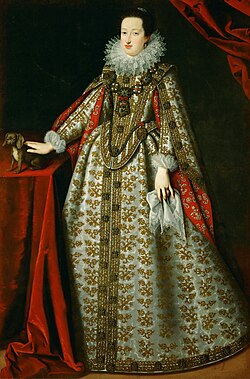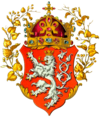Eleonora Gonzaga (1598–1655)
| Eleonora Gonzaga | |
|---|---|
Holy Roman Empress | |
| Tenure | 2 February 1622 – 15 February 1637 |
| Coronation | 7 November 1627 |
| Born | 23 September 1598 Mantua, Duchy of Mantua |
| Died | 27 June 1655 (aged 56) Vienna, Archduchy of Austria |
| Spouse | Ferdinand II, Holy Roman Emperor |
| House | Gonzaga |
| Father | Vincenzo Gonzaga, Duke of Mantua |
| Mother | Eleonora de' Medici |
Eleonora Gonzaga (23 September 1598 – 27 June 1655), was born a princess of
Nicknamed the Elder (German: Ältere) to distinguish herself from her namesake great-niece, during her tenure, the Imperial court in Vienna became one of the centers of European Baroque music. As empress, Eleanora was a supporter of the Counter-Reformation.
Life
Early years
Eleonora was born in

Two months after her birth, on 22 November, the princess was baptized at the

Eleonora spent her childhood at the ducal court in Mantua, which was one of the centers of European culture and science. When she was ten, her education was entrusted to her paternal aunt Margherita Gonzaga, Dowager Duchess of Ferrara and Modena, who, although she never took the veil, lived in a Clarissan monastery attached to the Church of Sant'Orsola, founded by herself. The dowager duchess saw to it that her niece received a good education, which included learning foreign languages, history, music and painting. The religious environment in which she grew up greatly influenced Eleonora, and was expressed in deeds of piety and charity.[5]
In early 1610, Duke Vincenzo negotiated a marriage between his 12-year-old daughter and Marcantonio IV Colonna, Duke and Prince of Paliano, and in March of that year a contract was signed under which a dowry was stipulated for Eleonora of 130,000 scudi. However, the negotiations quickly ended because of a previous marriage agreement of the Colonnas with the Doria family. Then, negotiations began for the marriage of Eleonora with Victor Amadeus, Prince of Piedmont and heir of the Duchy of Savoy; however, the intended groom expected a large territorial gain as a dowry, which the House of Gonzaga refused. Duke Vincenzo died in 1612, before he could arrange his youngest daughter's marriage.[4]
Marriage

In July 1621 the widowed Holy Roman Emperor Ferdinand II sent his Privy Councillor Prince Hans Ulrich von Eggenberg to Mantua, instructing him to negotiate his marriage with Eleonora. After obtaining the dispensation of the Holy See for the emperor's wedding with not only a relative (ratione consanguinitatis) but also his goddaughter (ratione affinitatis spiritualis ex baptismo contractae), on 21 November the contract was signed, which repeated the provisions made by Ferdinand II's first wife, and on the same day in the Basilica palatina di Santa Barbara at the Ducal Palace, Mantua the marriage per procura was concluded.[4][6]
The official wedding ceremony took place in
In spite of the great age difference between them, Eleonora and Ferdinand II had a happy marriage. They had no children, but Eleonora was able to develop a close relationship with all her stepchildren, particularly with the youngest one, Archduke Leopold Wilhelm, in whom she formed a taste for art and literature.[8] Like her husband, she was deeply religious and a strong supporter of the Counter-Reformation, being a benefactress of churches and monasteries and taking great interest in matters of charity. The confessors of the emperor and empress were Jesuits. Eleonora and her husband also shared a love for hunting and music; some time later, the emperor amended the marriage contract in favor of his wife.[4]
Holy Roman Empress and German Queen


Immediately upon her arrival in Vienna, Eleonora learned the German language. She hired servants of the previous empress, sending most of her native servants back to Mantua. Ferdinand II gave his wife the Favorita palace, which had previously belonged to his late wife. Later, she also received possession of the Laxenburg and Schönbrunn palaces.[4]
In
Eleonora wasn't interested in politics, but she tried to be a good empress for her subjects. She often accompanied her husband to meetings with the imperial electors, and the heads of states of the empire.[10] Among the many contributions made by her, was the construction of the chapel of the Madonna of Loreto in the Augustinian Church. Sanctified on 9 September 1627, the chapel became the second one used by the Imperial court. Behind the chapel, the Herzgruft was built, which later contained the hearts of members of the House of Habsburg. With the blessing of Pope Urban VIII, the empress built in Vienna a monastery of Discalced Carmelites, and bequeathed 80,000 florins in her will to pray for the salvation of her soul after her death. Together with her husband she founded another monastery of Discalced Carmelites in Vienna and was benefactress of the brotherhood which arranged for the burial of the homeless people. The empress also supported the Discalced Carmelite in Graz.[4]
Despite her attention to her German subjects, Eleonora didn't deny her support to her fellow Italian compatriots who came to her court.[11] The empress gave her patronage to Italian musicians and dancers.[12][13] Thanks to her, the Imperial court in Vienna became a center of European baroque music. She began the tradition of attending the opera and ballet performances during special celebrations in the Imperial family; the first one took place during Ferdinand II's birthday in 1625, and to this end, the Hofburg large wooden hall was built.[14][15]
A source of deep concern for Eleonora was the
Widowhood and later years

Emperor Ferdinand II died on 15 February 1637. Widowed, Eleonora settled in Graz Castle, near her husband's mausoleum. In the same year she moved to Vienna and settled in the Discalced Carmelites Monastery which she had earlier founded. According to contemporaries, the dowager empress led a pious life. She spent part of her time in her palaces outside the city, for example, in Schönbrunn, which was landscaped by her much in the spirit of the Italian baroque.[4][16][17]
On 18 April 1637 the monetary amount which belonged to her as dowager empress was settled on her, although this amount was changed repeatedly. The jewelry that she received from her husband during their marriage, including the one of diamond with pearls, given to her on their wedding day, was returned to the treasury of the House of Habsburg.[4]
As before, the empress dowager led an active correspondence with her Italian and Austrian relatives. She was authorized by
In her will, which was drawn up in 1651 and last amended shortly before her death, the dowager empress appointed her grandniece and namesake Empress Eleonora as her main heiress. In addition, she left considerable amounts for memorial services and charity. Eleonora, dowager empress and German queen, died in Vienna on 27 June 1655[2] aged 56 and was buried in the monastery of the Discalced Carmelites. The empress's heart was placed in a vessel, which is placed next to the tomb of her husband in his mausoleum. In 1782, her remains were transferred to St. Stephen's Cathedral in Vienna.[4]
Ancestry
| Ancestors of Eleonora Gonzaga (1598–1655) | |||||||||||||||||||||||||||||||||||||||||||||||||||||||||||||||||||||||||||||||||||||||||||||||||||||||||||
|---|---|---|---|---|---|---|---|---|---|---|---|---|---|---|---|---|---|---|---|---|---|---|---|---|---|---|---|---|---|---|---|---|---|---|---|---|---|---|---|---|---|---|---|---|---|---|---|---|---|---|---|---|---|---|---|---|---|---|---|---|---|---|---|---|---|---|---|---|---|---|---|---|---|---|---|---|---|---|---|---|---|---|---|---|---|---|---|---|---|---|---|---|---|---|---|---|---|---|---|---|---|---|---|---|---|---|---|
| |||||||||||||||||||||||||||||||||||||||||||||||||||||||||||||||||||||||||||||||||||||||||||||||||||||||||||
Notes
- ^ Ferdinand II in www.britannica.com [retrieved 27 November 2016].
- ^ a b c Semenov 2002, p. 198.
- ^ Braun, Keller, Schnettger 2016, pp. 118–119.
- ^ a b c d e f g h i j k l m Almut Bues: Eleonora Gonzaga, imperatrice – Dizionario Biografico degli Italiani - Volume 42 (1993) in: www.treccani.it [retrieved 27 November 2016].
- ^ Braun, Keller, Schnettger 2016, p. 119.
- ^ Braun, Keller, Schnettger 2016, p. 120.
- ^ Braun, Keller, Schnettger 2016, p. 123.
- ISBN 978-9-00-430378-2.
- ^ Braun, Keller, Schnettger 2016, p. 131.
- ^ Braun, Keller, Schnettger 2016, p. 132.
- ^ Raviola Blythe 2014, p. 43.
- ^ Braun, Keller, Schnettger 2016, p. 126.
- ^ Raviola Blythe 2014, p. 44.
- ^ Julia Teresa Friehs: The first opera at the imperial Viennese Court in: www.habsburger.net [retrieved 28 November 2016].
- ^ Braun, Keller, Schnettger 2016, p. 127.
- ^ Martin Mutschlechner: Schönbrunn before ‛Schönbrunn’ – the beginnings in: www.habsburger.net [retrieved 28 November 2016].
- ^ Braun, Keller, Schnettger 2016, p. 124.
- ^ Martin Mutschlechner: Ferdinand II: marriage and offspring in: www.habsburger.net [retrieved 28 November 2016].
- ^ Litta, Pompeo. Famiglie celebri di Italia. Gonzaga di Mantova [Famous families of Italy. Gonzaga of Mantua].
- Wurzbach, Constantin von, ed. (1860). . Biographisches Lexikon des Kaiserthums Oesterreich [Biographical Encyclopedia of the Austrian Empire] (in German). Vol. 6. p. 61 – via Wikisource.
- ^ a b c d e "The Medici Granducal Archive and the Medici Archive Project" (PDF). p. 12. Archived from the original (PDF) on 15 January 2006.
- Wurzbach, Constantin von, ed. (1860). . Biographisches Lexikon des Kaiserthums Oesterreich [Biographical Encyclopedia of the Austrian Empire] (in German). Vol. 6. p. 290 – via Wikisource.
- ^ a b c Amadei, Federigo (1955). Cronaca universale della città di Mantova [Universal chronicle of the city of Mantua] (in Italian). Vol. II. C.I.T.E.M.[page needed]
- ^ a b c Massarellus, Angelus. Dell'Imperadori Constantinopolitani [Of the Byzantine Emperors]. Codex Vaticanus Latinus. fols. 349v–353. 12127.
- ^ a b c Chisholm, Hugh, ed. (1911). . Encyclopædia Britannica. Vol. 15 (11th ed.). Cambridge University Press.
- ^ a b c Cazacu, Matei (2017). Reinert, Stephen W. (ed.). Dracula. Brill. p. 204.
- ^ ISBN 88-85957-36-6.
Bibliography
- Brigitte Hamann: Die Habsburger. 1988, p. 78f.
- Braun, Bettina; Keller, Katrin; Schnettger, Matthias (4 April 2016). Nur die Frau des Kaisers?: Kaiserinnen in der Frühen Neuzeit (in German). Böhlau Verlag Wien. p. 117. ISBN 978-3-205-20085-7.
- Raviola, Blythe Alice (2014). Corti e diplomazia nell'Europa del Seicento: Correggio e Ottavio Bolognesi (in Italian). Universitas Studiorum. p. 24, 43–44, 49, 171. ISBN 978-8-89-768364-3.
- Semenov, S. (2002). Christian European dynasty (in Russian). OLMA Media Group. p. 198. ISBN 978-5-22-402516-9.


